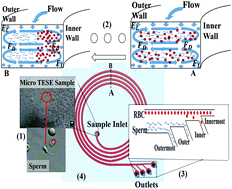Non-motile sperm cell separation using a spiral channel
Abstract
Microfluidic sperm sorting has historically relied on sperm motility. However, a motility-based sperm separation technology will not work when viable, non-motile sperm need to be separated from other tissues as occurs when performing testicular sperm extraction (TESE) and microdissection testicular sperm extraction (mTESE) techniques. This work demonstrates the use of inertial microfluidics technology using spiral channels to separate sperm from blood cells. The separation method, which is label-free, does not rely on sperm motility for sorting. Basic principles of spiral channel separations were used to design a specific channel and flow parameters for separating non-motile sperm from blood. The spiral channels dimensions were: initial radius, 0.7 cm; final radius, 0.899 cm; channel width, 150 μm; channel height, 50 μm; turns of spiral, 4 turns; and space between channels, 310 μm. If sperm are modeled as a 5 μm sphere, inertial microfluidics theory suggests that the sperm could be focused and separated from red blood cells (RBCs). Channels to implement these features were validated in a series of experiments. Mixed samples of RBCs and sperm were used to test the sperm separation capability of the device with the sample injection flow rate ranging from 0.1–0.52 ml min−1. After running the sample through the spiral channel, the samples were collected from four outlets and were inspected using microscopy. The best results were obtained at a 0.52 ml min−1 flow rate and generated a concentration ratio of 81%, representing the percent of sperm collected from the two outer outlets. For the same conditions, 99% of RBCs were collected from the two inner wall outlets. Using a high speed scanner, we were able to observe the focusing of the RBCs and general focusing of the sperm. As the sperm are not a uniform shape, they did not focus in a tight band, but were collected in a general region of the channel. Nevertheless, the purification ratio for these sperm was sufficient to greatly enhance the likelihood of finding rare sperm in TESE/mTESE samples containing millions of blood cells. Sequentially processing of the samples in the system proved to further improve the ratio of sperm to blood cells.

- This article is part of the themed collection: Microfluidics Research 2015-2016

 Please wait while we load your content...
Please wait while we load your content...